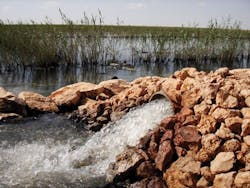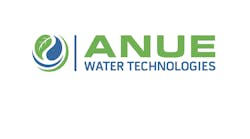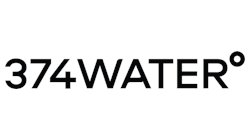Cooling towers scrub large volumes of air and effectively remove solids consisting of dust, microbiological organisms, and various airborne debris. Makeup to the tower adds suspended solids in the form of corrosion products, microbiological growths and wood fibers from the tower, and process leaks. If allowed to settle out, these solids can and do generate many problems within the system. With heavy solids loading, even the best treatment program can be severely strained. Under these circumstances, significant improvement might be realized with the use of a sidestream filter.
A proven method to help manage these and other issues surrounding cooling towers is to install a properly designed sidestream filter. This can benefit your system through:
- Reduced Corrosion Rates
- Increased Equipment Life
- Better System Efficiency
- Reduced Maintenance Costs
- Better Chemical Control
When to Consider Sidestream Filters
The installation of a sidestream filter is a capital expense, which may be hard to justify in most plants. Consider the following as indications that a plant should look into the possibility of installing a filter.
- The primary makeup is from an unclarified water source (river, sewage treatment, etc.) that is high in suspended solids and/or iron.
- The system is having a difficult biological problem even though a good biocide program is in effect.
- Heat exchangers are opening dirty even though a good antifoulant program is being used.
- Excessive corrosion rates can be traced to fouling.
- Loss of heat transfer is attributed to deposition rather than corrosion.
- High levels of solids are building up in the sump.
- Heat exchangers require frequent mechanical cleanings.
As stated, these are indicative only. By identifying potential threats to your systems and solutions to those threats, you can determine the paybacks of installing a sidestream filtration system. Often the payback is less time than you would think. This will vary widely from system to system; the final decision will always rest with a plant, and will always be decided on economic grounds.
Sidestream Filter Benefits
Once a problem has been recognized, several benefits can result from the use of a sidestream filter. Obviously, not all of those listed below apply to all systems, and good judgment must be applied before making any claims. However, bearing that in mind, the following benefits can be realized:
- Since solids are removed from the system, the corrosion inhibitor will lay down its protective film on clean rather than dirty surfaces, thereby reducing corrosion rates and increasing equipment life.
- When used with good chemical treatment, the filter will keep the system much cleaner, and, as a result, the need for mechanical cleaning of exchangers and sumps is reduced.
- A cleaner system means better heat-transfer rates for longer periods of time.
- In some cases, the removal of suspended solids from the circulating water allows higher cycle.
- Large biological growths and dead organisms are removed with a sidestream filter. This reduces chlorine demand and makes nonoxidizing biocides more effective.
Filter Design
It is strongly recommended that a particle analysis be done on the representative stream that is to be treated. This can be reviewed while planning your sidestream treatment. For most sidestream filtration, a centrifugal style filter is optimal. It will remove the major problems your system faces and require very little maintenance or repair. However, each filter product does have its limits.
Centrifugal Filters
The minimum particle size typically removed is 80 micron. This happens only when the particles are all 1.2 times the density of water or higher. These types of filters are more likely found in a mixed stream where 200 micron can be planned upon.
Auto-Backwashable Screen
This screen size is relatively absolute so the system can be customized to the particle size desired. Screens are available down to 20 microns (10 microns listed, but is not real durable for most tower applications). There is a problem if the particle size goes too low. The amount of water needed to backwash the screen can be excessive. Also, the debris can stick to the screen requiring manual clean up.
Bag Filters
This filter requires labor in changing out the bags when full. However, bag filters offer the flexibility of adjusting the micron filtration provided when needed (for instance in cottonwood seed time).
Cartridge Filters
The initial expense of these filters is comparable with other filters; however, the ongoing expense is much higher. Cartridge filters offer flexibility like bag filters, but with little or no bypass.
Sand Filters
While sand filters are the most expensive of all the filters listed here, they are proven effective and reliable. When set up to backwash on pressure differential, they can handle load variations with manpower.
Filter Media
Size of the medium is important, since it must:
- Stop suspended solids from passing through
- Hold solids loosely for easy removal during backwashing.
- Be capable of holding a given quantity of solids without clogging
Medium size is defined by two figures:
- Effective Size: Particle size above which 90% of the medium is larger
- Uniformity Coefficient: Effective size divided into the particle size above which 90% of the medium is larger.
In most cases, sand or anthracite is the filter medium used, and sometimes the two will be used together (mixed media). The filter beds contain different-size layers of the media. Fine sand or anthracite will be on top, with larger and coarser grades underneath. These will be supported on graded gravel or heavy anthracite.
Most filters operate at a filtration rate of 2 to 3 gallons per minute per square foot of filter surface. Backwash rate is enough to expand the filter bed by 50%, usually 10 to 20 gallons per minute per square foot for sand and 5 to 10 gallons per minute per square foot for anthracite.
Filter media will usually be selected to:
- Remove those particles with the greatest tendency to settle.
- Be least expensive for a given water throughput.
- Require a minimal backwash rate.
Filter Sizing
Historically, filters were designed to handle approximately 2% of the circulating rate. This rule of thumb has proved inadequate for the design of sidestream filters in modern industrial plants, and a sounder engineering approach is now being used.
If the suspended solids entering the system is constant, and known, and the solids desired is also known, and these two conditions are in equilibrium states (little variation of either), the filter size can be determined by:
Again, this requires the existence of a steady-state condition. When the contamination entering a system is erratic because of varying solids entering the system with the makeup (for instance, after a heavy rain), or with the air (for instance, wind shifts changing the dust level in the air), this equation cannot be used.
The following formula for the calculation of filter size assumes that the varying solids loading must be removed from the system in a period of time that is practical, yet short enough so that serious deposits will not form. In practice, a 95% reduction of a sudden solids load in 1 to 3 days will prevent excessive fouling and allow a filter size that is not prohibitively expensive. The formula used is:
The information on filter design and sizing is provided only as a guide. The specifics are better left to manufacturers of the filtration equipment.
Summary
Sidestream filtration is an effective tool for the control of deposition and fouling in a cooling water system. Owing to the capital investment required, its use should be carefully considered. It should not be recommended or used as a substitute for good engineering practices, good control, or good programs, nor should it be used to overcome basic design flaws in the system.
About the Author: Dan Lingen is Business Development Manger for US Water Services. He has 24 years of experience in the water treatment industry. His areas of expertise includes use of filtration, DAF, reverse osmosis and polymers in water reuse applications, and boiler and cooling water systems.




